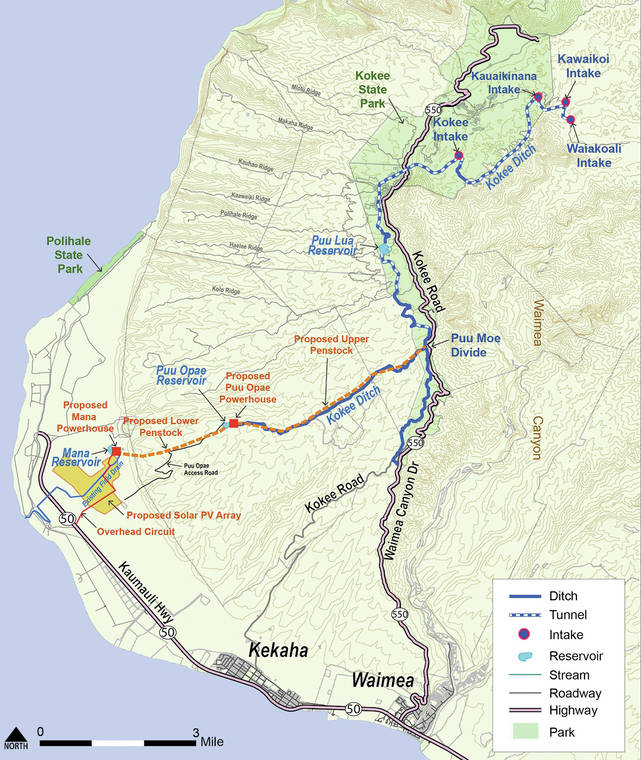LIHU‘E — Kaua‘i Island Utility Cooperative Communications Manager Beth Tokioka said there is still no time frame for the state Public Utilities Commission to approve the purchase-power agreement between AES Corporation and KIUC.
The agreement proposal was filed with the PUC on Dec. 31, and publicly announced on Jan. 7.
The agreement would pay AES an estimated $8.9 million per year via a hydropower capacity charge for 24 megawatts of firm renewable capacity.
“We are hopeful that we will have an answer from the HPUC by this summer,” Tokioka said.
Building a renewable future
The agreement would include development, construction and operation of a solar-pumped hydro project, the West Kaua’i Energy Project (WKEP).
The project would provide firm renewable power for longer durations than possible now with current solar storage.
Currently, the lithium-ion batteries available for solar storage can only provide four to five hours of dispatch overnight.
The hydro storage provided by this project will provide 12-plus hours of dispatch, which will meet nearly 25% of the island’s electricity needs, she said.
“What this project will do is provide a very large additional renewable source that has different attributes than solar,” Tokioka said. “This will complement our renewable mix.”
The costs of the sustainability
The average annual cost for the operation of the WKEP would be $150 per megawatt-hour.
KIUC estimates that the project would save KIUC and its members between $157 million and $172 million (net present value using a 5% discount rate) versus the projected cost of diesel over the 25-year term of the purchase-power agreement.
According to KIUC, this agreement would provide numerous benefits to grid operations, the environment and the community at-large.
At this juncture, the transition between the Donald Trump and Joe Biden administration could impact the logistics of the agreement, and it is unknown how the change of administrations will affect state and federal tax credits.
According to Tokioka, treatment of federal tax credits for renewable technology can have a significant impact on the cost of renewable deployment.
If federal tax credits are reduced or eliminated, that will increase the cost of the project, and that cost will be passed on to the customer.
“Should the new administration extend or enhance tax credits, KIUC and other utilities will be able to develop new renewable projects,” Tokioka said. “This is a more-cost-effective manner, and will result in savings to the consumer.”
As it stands now, KIUC will pay AES $71.60 per megawatt-hour for energy produced by the solar photovoltaic and battery system over the 25-year term of the purchse-power agreement.
The current agreement is 34% lower than KIUC’s current operating costs of the utility-scale solar facilities, according to David Brissell, KIUC president and CEO.
As it stands now, KIUC is running on more than 60% renewable generation, which is a 10% increase from a decade ago.
“We have been mandated by the state of Hawai‘i to reach 100% renewable generation by 2045,” Tokioka said. “This project will bring us to 80% renewable generation, hopefully by 2024.”
The WKEP will directly offset the use of 8.5 million gallons of oil annually, which will keep KIUC ahead of the state’s goals.
“Accomplishing all of that while saving hundreds of millions of dollars is something we can all be proud of,” Brissell said.
Long-term savings
Several communities will benefit from the WKEP.
The project aims to rehabilitate the existing Pu‘u ‘Opae, Pu‘u Lua and Mana reservoirs and the related ditch-system infrastructure.
“With the rehabilitation of the reservoirs and irrigation infrastructure, it’ll supply irrigation water delivery to support diversified agriculture on state-owned lands,” Tokioka said. “There will be enhanced recreational facilities created at Pu‘u Lua Reservoir.”
The historic diversion structures in Koke‘e will be changed to restore and increase flow to the Waimea River in compliance with the instream flow standard established by the Waimea Watershed Agreement and adopted by the state Commission on Water Resources in April 2017.
It will also provide a source of water for firefighting on the Westside and in Koke‘e.
“Delivering solar storage at such a low price, along with the long-duration hydro storage, is replacing diesel with substantial amounts of a firm and renewable power,” Brissell said. “With all of the community and environmental benefits that come with the project, it is remarkable.”
•••
Jason Blasco, reporter, can be reached at 245-0437 or jblasco@thegardenisland.com.






in other words….current solar technology does not make economic sense…
Need more transparency on this topic- community needs opportunities to fully understand how our KIUC is spending our money and utilizing our resources here on Kaua’i – especially water issues!!!
We need more transparency on this subject- how KIUC is spending our money and using our valuable water resources-